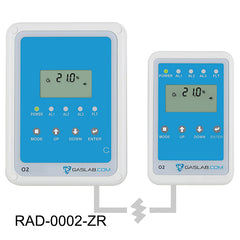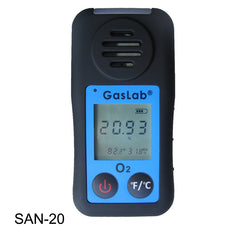Oxygen Safety Applications
Our oxygen depletion safety alarms and oxygen enrichment safety alarms use long-life optical oxygen sensors.
Our oxygen safety devices warn you and your employees if there is too much or too little oxygen in a room or enclosed area. All our devices use an oxygen sensor that you install near tanks of compressed gas to continuously read oxygen levels, and a remote monitor you install outside the door that warns you of any problem before you enter the room.
- Designed to meet all local fire codes
- Meets NFPA, IFC, and NBIC requirements
- Meets OSHA and NIOSH TWA standards
- UL listed for compliance
Oxygen Deficiency Safety

An oxygen deficiency monitor or oxygen depletion alarm is used to alert staff before they enter an enclosed area with low oxygen levels.
Oxygen levels below 21% are the result of a pressurized gas leak from another stored gas. This makes is especially useful in businesses or laboratories that use bulk storage tanks for nitrogen, helium, oxygen, welding or cryogenic gases.
Common Oxygen Depletion Safety Applications
- Stored nitrous oxide or nitrogen in hospitals
- Cryogenics research in cryo-biology
- Cryogenic therapy
- Labs using helium to cool MRI machines
- Liquid nitrogen, helium or argon storage for IVF, cryosurgery
- Food packaging plants that use liquid nitrogen
- Factories that use argon or other shield gases for welding
- Factories that use sealed AM machines or 3D printers
- Diving supply shops that mix gases to refill SCUBA tanks
- Data centers that use argon or other inert gases for fire suppression
See our oxygen depletion safety alarms.
Oxygen Enrichment Safety

An oxygen enrichment alarm is used to alert staff when oxygen levels in an enclosed area are higher than normal indoor air.
More than 21% oxygen by volume air in enclosed spaces are the result of a leak from stored or produced oxygen system. While OSHA defines anything above 23.5% oxygen as dangerous, studies show that long term recovery is possible once oxygen levels are reduced. The bigger issue is that oxygen enrichment increases the risk of fire.
Common Oxygen Enrichment Safety Applications
- Steel manufacturing
- Welding and cutting
- Medical breathing gas storage
- Diving tank filling
- Bulk oxygen production


